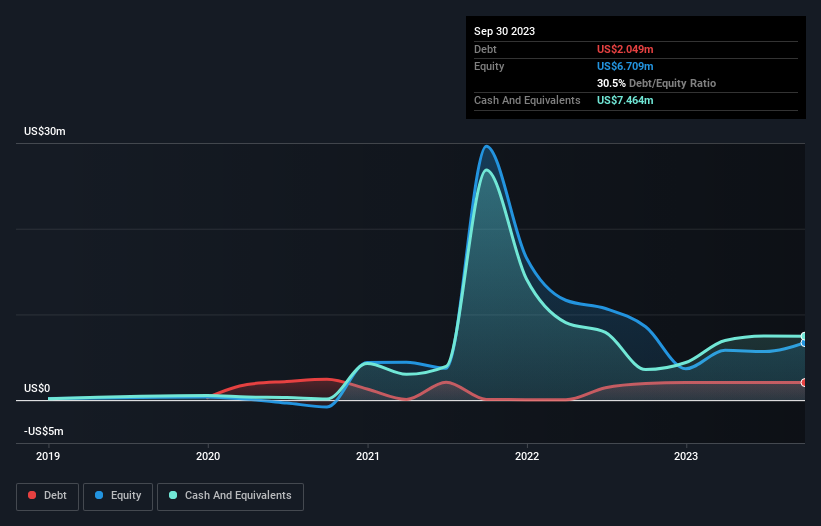- United States
- /
- Personal Products
- /
- NasdaqCM:SHOT
Is Safety Shot (NASDAQ:SHOT) Using Debt In A Risky Way?

Some say volatility, rather than debt, is the best way to think about risk as an investor, but Warren Buffett famously said that 'Volatility is far from synonymous with risk.' When we think about how risky a company is, we always like to look at its use of debt, since debt overload can lead to ruin. As with many other companies Safety Shot, Inc. (NASDAQ:SHOT) makes use of debt. But the more important question is: how much risk is that debt creating?
Why Does Debt Bring Risk?
Debt and other liabilities become risky for a business when it cannot easily fulfill those obligations, either with free cash flow or by raising capital at an attractive price. Part and parcel of capitalism is the process of 'creative destruction' where failed businesses are mercilessly liquidated by their bankers. However, a more frequent (but still costly) occurrence is where a company must issue shares at bargain-basement prices, permanently diluting shareholders, just to shore up its balance sheet. Having said that, the most common situation is where a company manages its debt reasonably well - and to its own advantage. The first step when considering a company's debt levels is to consider its cash and debt together.
See our latest analysis for Safety Shot
How Much Debt Does Safety Shot Carry?
The image below, which you can click on for greater detail, shows that at September 2023 Safety Shot had debt of US$2.05m, up from US$1.94m in one year. However, it does have US$7.46m in cash offsetting this, leading to net cash of US$5.41m.

How Strong Is Safety Shot's Balance Sheet?
The latest balance sheet data shows that Safety Shot had liabilities of US$4.26m due within a year, and liabilities of US$358.9k falling due after that. Offsetting these obligations, it had cash of US$7.46m as well as receivables valued at US$3.0k due within 12 months. So it can boast US$2.84m more liquid assets than total liabilities.
This surplus suggests that Safety Shot has a conservative balance sheet, and could probably eliminate its debt without much difficulty. Simply put, the fact that Safety Shot has more cash than debt is arguably a good indication that it can manage its debt safely. There's no doubt that we learn most about debt from the balance sheet. But you can't view debt in total isolation; since Safety Shot will need earnings to service that debt. So when considering debt, it's definitely worth looking at the earnings trend. Click here for an interactive snapshot.
Over 12 months, Safety Shot made a loss at the EBIT level, and saw its revenue drop to US$4.9m, which is a fall of 29%. To be frank that doesn't bode well.
So How Risky Is Safety Shot?
By their very nature companies that are losing money are more risky than those with a long history of profitability. And the fact is that over the last twelve months Safety Shot lost money at the earnings before interest and tax (EBIT) line. And over the same period it saw negative free cash outflow of US$6.0m and booked a US$18m accounting loss. However, it has net cash of US$5.41m, so it has a bit of time before it will need more capital. Even though its balance sheet seems sufficiently liquid, debt always makes us a little nervous if a company doesn't produce free cash flow regularly. The balance sheet is clearly the area to focus on when you are analysing debt. However, not all investment risk resides within the balance sheet - far from it. For example Safety Shot has 6 warning signs (and 4 which are a bit unpleasant) we think you should know about.
When all is said and done, sometimes its easier to focus on companies that don't even need debt. Readers can access a list of growth stocks with zero net debt 100% free, right now.
If you're looking to trade Safety Shot, open an account with the lowest-cost platform trusted by professionals, Interactive Brokers.
With clients in over 200 countries and territories, and access to 160 markets, IBKR lets you trade stocks, options, futures, forex, bonds and funds from a single integrated account.
Enjoy no hidden fees, no account minimums, and FX conversion rates as low as 0.03%, far better than what most brokers offer.
Sponsored ContentNew: Manage All Your Stock Portfolios in One Place
We've created the ultimate portfolio companion for stock investors, and it's free.
• Connect an unlimited number of Portfolios and see your total in one currency
• Be alerted to new Warning Signs or Risks via email or mobile
• Track the Fair Value of your stocks
Have feedback on this article? Concerned about the content? Get in touch with us directly. Alternatively, email editorial-team (at) simplywallst.com.
This article by Simply Wall St is general in nature. We provide commentary based on historical data and analyst forecasts only using an unbiased methodology and our articles are not intended to be financial advice. It does not constitute a recommendation to buy or sell any stock, and does not take account of your objectives, or your financial situation. We aim to bring you long-term focused analysis driven by fundamental data. Note that our analysis may not factor in the latest price-sensitive company announcements or qualitative material. Simply Wall St has no position in any stocks mentioned.
About NasdaqCM:SHOT
Safety Shot
Provides over-the-counter products and consumer products in the United States.
Medium-low with imperfect balance sheet.
Market Insights
Community Narratives




